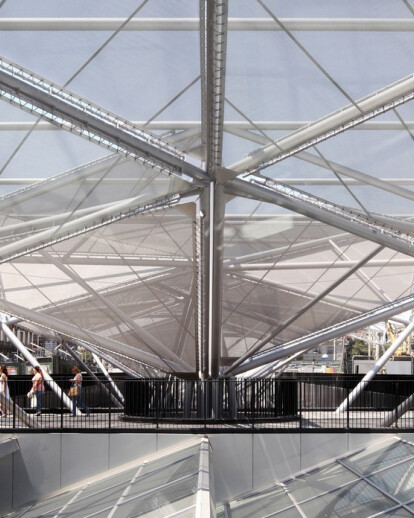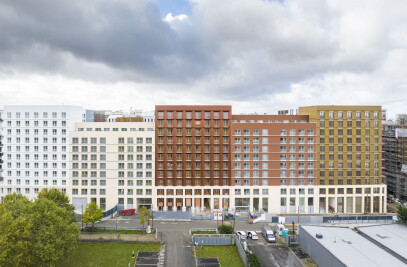After two achievements in the north of Italy – the NH-Fieramilano Hotel in the northwest of Milan delivered in 2008 and the redesigning of the Piazza Gramsci (2004), central place of Cinisello Balsamo, city located a few kilometres from the Milan capital-, Dominique Perrault makes his mark in the southern provinces of the peninsula, benefiting from the upcoming arrival of a metro station to orchestrate the –in-depth- transformation of a major public space in the heart of Naples: The Piazza Garibaldi.
After a striking proposition made on the occasion of the international architecture competition for the creation of the future TGV Napoli station - Afragola (Treno Alta Velocita) in 2003 - the architect of the Grande Bibliothèque is entrusted, from 2004, by the Metropolitana di Napoli with the studies for the redesigning of the Piazza Garibaldi, but also the realisation of the eponym subway station on the new line 1. It’s an effervescent scene where the Neapolitan intensity explodes, and where more than 50 millions of people pass by every year. The Piazza Garibaldi on which watches over- face to the central station - the statue of the man called “the hero of the Two Worlds” gathers in a happy chaos the historic heart of Naples and the new business district set up on the former warehouses of the City: the Centro Direzionale.
This square is a link of almost 6 hectares. It relies on a heterogeneous built heritage, and until now it was used as a huge available space serving the intermodality and the moving, without properly qualifying the public space to host the urban practices, and only offers to the residents, travellers and walkers, few spaces dedicated to the ramble and the relaxation.
The future presence of a new transport infrastructure on the square underlines even more the multimodal character of an urban space, huge as the gathered Parisian places of la République and Bastille. The Piazza Garibaldi, esplanade of the remarkable central station, designed by the architects Pier Luigi Nervi, Bruno Zevi, and Luigi Piccinato, recently renovated, and whose triangular patterns of the roof is today part of the collective imagination of Naples, also concentrates the flows generated by the bus station, the tramway, the metro line 2, the Circumvesuviana, but also by the road exchanges, the bicycles and the pedestrians of the downtown.
THE GEOMETRY SERVING THE GEAORGRAPHY Dominique Perrault takes cleverly advantage of the addition of a new metro station in the plan, to reform an urban space full of vitality but marked by the intensity of the car traffic, the fragmentation of the pedestrian spaces and the discontinuity of the itineraries. The square whose the present configuration only dates back from the demolition of the 19th historic station in the early sixties, constitutes a void of 360 meters by 165, without making up or particular structure from the square where is located the general of the Mille Expedition to the new central station. To wake up a territory of such a dimension, the architect works by division and sets up on the square several places, more adapted to the pedestrian scale, so that the uses increase and the urbanity of the square operates both by day and by night. Perrault isn’t building one but four squares.
On the east side, there are the historic square of the 19th century and the tramway ensuring the connection to the north with the Piazza Prince Umberto and to the south with the Piazza Nolana. On the north side, on more than 200 meters long, a series of parks and gardens as well as a water point marking the access to the metro bring some freshness to the square. In front of this landscaping device, a huge and open commercial gallery, inserted into the ground at 8 meters below the square level, slides and seeps down under the ground to join, through a network of buried galleries, the other stations. This is the shops square and the flowers market. On the west side, in front on the central station, the piazza intermodale forms the new esplanade of the railway and bus stations (bus and taxi). The tops of the tall metal trees shading the new gallery are organized on the height of the V-shaped roof of the station. The physical proximity between the both structures opens a dialogue that is carried on in a chromatic and formal dialectic. Textile, the new roof extends in a firmly contemporary and fundamentally immaterial writing the triangular patterns designed by the architects from the station to the historic square. Stretched hands over the ages. In an assumed proximity with the French school of landscape, Dominique Perrault partitions the space and organizes the general landscape and urban composition by deporting the traffics on the square’s periphery in order to free its heart. This loop anchors even more the place into the surrounding urban fabric through the connections with the adjacent streets.
THE MECHANICS OF THE GROUND In the requalification process of the piazza, the French architect mobilizes history to calm down geography. And vice versa…the project staging the history that it shows. Because in Naples history is everywhere. Registered on the UNESCO world heritage, the ancient City of Naples preserves, with an incredible density, the remains of a 3000 year-old history. From the Castel dell’Ovo sat on the Gulf of Naples to the Gesù- Nuevo, from the Royal Palace to the huge glass vaults of the Galleria Umberto 1°, from the ancient theatre to the treasures of the Risorgimento, the city shows the richness of its history. This generosity can be found everywhere in the basements of the city. Those basements hide here and there a maze of networks, quarries and pathways going sometimes deeper than 30 meters. With a touch of irony, the basement of the Garibaldi square, located at the link of the ages of the city, at the inflection point of history, is devoid of any archaeological remain. This configuration is at the origin of the project led by the architect: “That is a fact, to some extent, we are a little jealous of the other metro sites, where there are some ruins, where there are some traces of history. So we created our own traces of history and we inserted into the ground a huge gallery. The principle is what is below the ground comes up in a special way above the ground, or at least, with some natural light. This underground network comes up sometimes and allows to introduce this quality of natural light into the depths, to the metro station located at 40 meters down into the ground.”
The miracle of Perrault, said Massimiliano Fuksas recently, about the station of Naples, is bringing down the light to the platform, to the depths of the metro, at 40 meters from the square, showing the stomach and the entrails of Naples but also injecting the city’s activity in the ground that history hadn’t taken over yet. Perrault merges the outside and the inside, the infrastructural and the urban. He stages the depth and writes the experience of the burying and the underground by extending the uses and the views between above and below. The “Garibaldi” metro station isn’t a subway entrance, no more than a monument station, but something extending, stretching and coming undone to bring closer and give life to the present elements of this downtown square. This “architectonic of the link”, frequently used in the projects of the architect is based on mobility, moving and interactivity in order to establish the space. As a therapist, the architect reconciles the access vertical dynamics of the transportation system with the horizontal movements of the city. Expert in the burying of architecture, Perrault forbids the threshold effect by blurring the limits between the city and the station.
In the central body, the mechanic escalators unfold and fold up. They regularly turn over and reverse under the Neapolitan sky. A single shiny metal sculpture with hard edges, whose regular meandering ignores the presence of some impressive struts necessary for the structural stabilisation of the infrastructures. High point of the device, the traveller ends his descent in front of a work of the artist Michelangelo Pistoletto, setting up the platform and his waitings at the foot of the escalators. The miracle of Perrault, it’s the metamorphosis of a work of art – the Garibaldi station – into a place where the practice of the city is reinvented.
Jérémy Moles DPA Communication

































